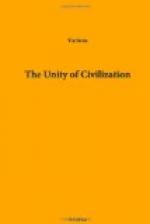Metal, and even stone, implements do not help us much further, though they were traded more widely than pottery, and form larger provinces. In modern Europe, in the same way, pocket-knives are rather more uniform than milk-jugs; and where they differ, are referable to fewer types. But there is no unity, nor for the present any prospect of it. For anything more, we are reduced to the great crises of material culture, such as the introduction of bronze, of iron, of glass and glazed earthenware; and these we perceive increasingly not as turning points of the whole, but as processes within it, affecting now one region, now another, in a sequence which is clearly geographical and at very variable speed. Bronze, for example, took some thousands of years to permeate the continent of Europe; iron perhaps as many hundreds; platinum a little more than fifty years; and radium less than five.
What we do get from this material evidence, however, is a quite indisputable sequence of styles in time in each locality where we can hit upon stratified remains. Dead men, they say, tell no tales; potsherds are as truthful and eloquent as they are, for the very reason that, once broken, they are dead and done with, and are allowed to lie quiet in their rubbish heaps. Intervals indeed we cannot so easily measure; but of sequences we can be sure, and by comparing the sequences on different sites we can go far towards tracing the spread and supersession of a style, sometimes over wide areas, and occasionally, with the help of the geography, we can be pretty sure of the routes by which innovations travelled. We can infer nothing, however, from this as to the movements of people: the vogue of the willow-pattern plate is no measure of our ‘yellow-peril’. But where works of art can travel, ideas can travel too; and can travel right across the frontiers of race and language and even of religion; meaning at all events by these, the customary observance of each region, and of its endemic population. A few merchants, or craftsmen, or philosophers, work transformations in culture and bring about uniformities, of which language, or cult-edifices give us no indication at all, or at best an aftermath of decadence.
It is not a merely ephemeral interest which draws attention at this point to the significance of engines of war, among this class of transferable inventions. Little has been done in a systematic way on this topic, but the rapidity with which a really important change in equipment and organization passes from camp to camp, and revolutionizes not only armies but states, when it is a question of survival or defeat, has its illustration in many phases of warfare, and ranks among the great levellers of national or regional pride.




